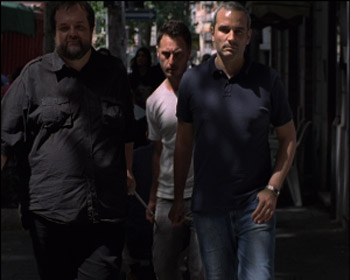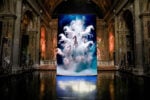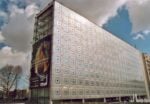Rosalind Nashashibi – La Visione di Carlo

La mostra presso Peep-Hole e Nomas Foundation è la prima mostra personale dell’artista in Italia. In quest’occasione Nashashibi presenta Carlo’s Vision (2011), un film in 16mm realizzato appositamente per la mostra.
Comunicato stampa
Wednesday, 14 September Peep-Hole presents La Visione di Carlo (Sacro e Profano) [Carlo's Vision, Sacred and Profane], the first institutional solo exhibition in Italy by Rosalind Nashashibi, developed in collaboration with Nomas Foundation, Rome.
The exhibition takes the form of a dyptich divided in two venues subtitled respectively Sacred and Profane and Body Habits.
Common element and leading thread of the two exhibitions is the new film Carlo's Vision commissioned by Nomas Foudation and Peep-Hole and produced by the Stefano and Raffaella Sciarretta Collection.
Carlo’s Vision (2011) is a 16mm film based on an episode in the unfinished novel Petrolio by Pier Paolo Pasolini. Petrolio gives us a picture of the Italian contemporary world, a crucial contribution to the understanding of what happened in Italy between the Sixties and the Seventies. The artist moves from the vision of the main character, Carlo. Nashashibi’s intention is not to make the vision as Pasolini described it into a film but rather to shift the vision in today's context and let it clash with reality. The structure, the main characters and props will be taken from the novel, but the rest will be left to reality and observation. Petrolio was set at the end of the Sixties, Nashashibi’s film sets the vision on Via di Tor Pignattara this summer. Carlo perceives reality in a different intensity of time, light and colour to that experienced by the rest of the street. Nashashibi’s film takes a ritual and a vision from outside of time, and drops it into the most ordinary part of the day, creating a friction where the simultaneous realities rub against one another.
At Peep-Hole, La Visione di Carlo (Sacro e Profano) also features Shelter for a New Youth (2011), a mixed-media installation in which the artist first showed her interest in Petrolio. The work was completed earlier this year for Sharjah Biennial and it comprises photographs of male crotches and painted panels showing the hands of Mickey Mouse as the hands of Buddha. One hand is pointed upwards and the other downwards, in a gesture that suggests openness and acceptance but also ambivalence.
A screening of Rosalind Nashashibi’s latest film and a talk with the artist will be presented in Rome and in Milan. Venues and dates will be confirmed soon.
The research of Rosalind Nashashibi (1973) is focused on the aesthetic of everyday life in urban environments. The artist moves away from representation to privilege experience as the locus of consciousness. Often two elements are juxtaposed in order to make visible different layers of reality that co-exist in one moment, or a constructed scene, a fiction is set into a real situation. She mainly works with cinema where the melancholic drift of time passing place the viewer in a position of experiencing the present. Her most recent solo shows include those at Tulips and Roses, Brussels (2010); ICA, London (2009); Bergen Kunstalle, Bergen (2009); Kustlerhaus, Stuttgart (2009); Presentation House, Vancouver (2008); Professional Gallery, OCAD, Toronto (2008); Berkeley Art Museum, Berkeley (2007); Art Basel Statements with Harris Lieberman (New York), Basel (2007); Kunsthalle, Basel (2004); Tate Britain, London (2004). She has also participated in numerous group exhibitions such as: Time Again, SculptureCenter, New York (2011); The Art of Narration Changes with Time, Galerie Sprueth Magers, Berlin (2011); Erre (Variations Labyrinthiques), Pompidou Metz (2011-2012); Repetition Island, Centre Pompidou, Paris (2010); Into the belly of a Dove, Tamayo Museum, Mexico City (2010); Sculpture of the Space Age, David Roberts Art Foundation, London (2009); Displaced, UCLA, Los Angeles (2003). She also participated at Sharjah Biennial X, Sharjah (2011); Manifesta 7, Trento (2008); Venice Biennale, Venice (2007, 2003); Momentum Nordic Biennial (2011, 2006); Berlin Biennial, Berlin (2008; with Lucy Skaer).
Mercoledì 14 settembre Peep-Hole presenta La Visione di Carlo (Sacro e Profano), la prima mostra personale in Italia di Rosalind Nashashibi realizzata in collaborazione con Nomas Foundation, Roma.
La mostra è declinata nelle due sedi come due parti di un dittico che prendono rispettivamente i sottotitoli Sacro e Profano e Vizi di Forma.
Carlo’s Vision (2011) è un cortometraggio in 16 mm, girato a partire da un episodio di Petrolio, il romanzo incompiuto di Pier Paolo Pasolini. Petrolio è un ritratto del mondo contemporaneo italiano, un contributo cruciale alla comprensione dei fatti accaduti in Italia tra gli anni Sessanta e Settanta. L’artista parte dall’episodio del romanzo che illustra la visione di Carlo, il protagonista. L’obiettivo di Nashashibi non è tradurre puntualmente la visione di Pasolini in un film, ma di proporre una visione equivalente nel contesto odierno e lasciare che essa si scontri con la realtà per vederne il risultato. La struttura, i personaggi principali e la scena sono gli stessi del racconto mentre il resto, il contesto, è lasciato alla realtà e all’osservazione. La visione su Via di Tor Pignattara contenuta in Petrolio è ambientata negli anni Sessanta; il film di Rosalind Nashashibi nell’estate del 2011. Carlo percepisce la realtà con un’intensità del tempo, della luce e del colore differenti da quelli vissuti dal resto della strada, dai passanti con i quali si scontra. Il film di Rosalind Nashashibi coglie un rituale e una visione al di fuori del tempo e lo consegna alla quotidianità, creando e provocando una frizione dove realtà simultanee si sfiorano.
Negli spazi di Peep-Hole La Visione di Carlo (Sacro e Profano) presenta inoltre Shelter for a New Youth (2011), un’opera installativa realizzata in occasione della Biennale di Sharjah nella quale emerge per la prima volta l'interesse dell'artista per Petrolio. L’opera è composta da una serie fotografica di parti basse maschili e da alcuni dipinti che mostrano le mani di Topolino così come sono rappresentate nell’iconografia di Buddha dove una mano punta verso l'alto e l’altra verso il basso, in un gesto che indica non solo apertura e accettazione ma anche ambivalenza.
Successivamente all’apertura della mostra, si terranno a Roma e a Milano due serate di incontro con l’artista e screening dei suoi film recenti. Luoghi e date saranno comunicati a breve.
La ricerca di Rosalind Nashashibi (1973) si concentra sugli attimi d’intensità insiti nella vita quotidiana e nei contesti urbani. L’artista si allontana dalla rappresentazione per privilegiare l’esperienza come spazio della coscienza. Spesso due elementi sono giustapposti per rendere visibili differenti livelli della realtà che coesistono allo stesso momento, oppure una scena costruita, una finzione, è posta in una situazione reale. L’artista lavora principalmente con il mezzo cinematografico, dove il melanconico scorrere del tempo si espande e l’osservatore è messo in una condizione di verifica del presente. Tra le mostre personali si ricordano le più recenti presso: Tulips and Roses, Bruxelles (2010); ICA, Londra (2009); Bergen Kunstalle, Bergen (2009); Kustlerhaus, Stoccarda (2009); Presentation House, Vancouver (2008); Profession Gallery, OCAD, Toronto (2008); Berkeley Art Museum, Berkeley (2007); Art Basel Statements con Harris Lieberman (New York), Basilea (2007); Kunsthalle, Basilea (2004); Tate Britain, Londra (2004). Tra le mostre collettive: Time Again, SculptureCenter, New York (2011); The Art of Narration Changes with Time, Galerie Sprueth Magers, Berlino (2011); Erre (Variations labyrinthiques), Pompidou Metz, Metz (2011-2012); Repetition Island, Centre Pompidou, Parigi (2010); Into the belly of a Dove, Tamayo Museum, Città del Messico (2010); Sculpture of the Space Age, David Roberts Art Foundation, Londra (2009); Displaced, UCLA, Los Angeles (2003). Nashashibi ha inoltre partecipato a: Sharjah Biennial X, Sharjah (2011); Manifesta 7, Trento (2008); Biennale di Venezia, Venezia (2007, 2003); Momentum Nordic Biennial (2011, 2006); Berlin Biennial, Berlino (2008, con Lucy Skaer).



